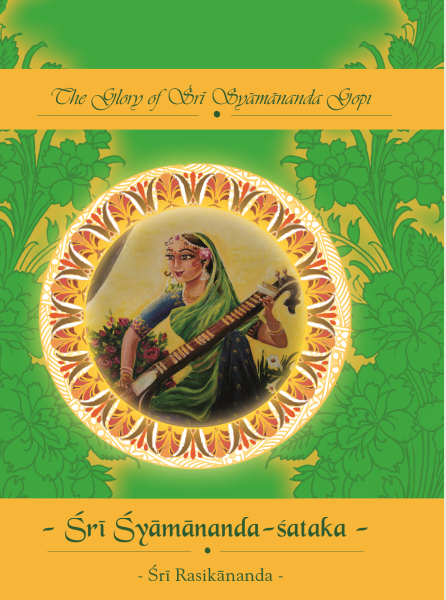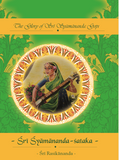Sri Syamananda Sataka: The Glory of Sri Syamananda Gopi
Sri Syamananda Sataka: The Glory of Sri Syamananda Gopi
by Sri Rasikananda (Author), Translated by Kusakrtha Dasa , Edited By Purnaprajna Dasa
Rasikänanda met his spiritual master,
Syämänanda, when he was an eighteen-year old
youth named Rasika Muräri Patnaik,
and later on became known as his chief
disciple. He was born in 1590 AD, fifty-six
years after the disappearance of Sri Caitanya
Mahäprabhu. He was the son of a wealthy
landowner in West Bengal.
Rasikänanda vigorously preached so
that he became a very influential spiritual
master who firmly established the sect known
as Syämänandi Vaisñavas, devotees who
execute Krsña consciousness in the mood of
his guru. This book, Syämänanda-sataka, was
written in the latter part of Rasikänanda’s life
and it is purely glorification of his spiritual
master, revealing his eternal relationship
with Lord Sri Krsna.In text 27 it is revealed that
Syämänanda was a hopé associate of Rädhä
and Krsña who left the spiritual world to
descend into this material world for the
purpose of displaying his mercy upon the
fallen conditioned souls struggling in Kaliyuga.
Like an actor on the stage, he played
the part of a human being, causing the
unfortunate souls of this age to fall in love
with Krsña.
Toward the end of his life, Rasikänanda
settled in Remuna, Orissa, where the Deity
of Ksira-corä Gopinätha is situated. The
samädhi of Rasikänanda Prabhu can still
be seen within the temple of Kñéra-corä
Gopinätha at Remuna.
Syämänanda was a disciple of Hrdaya
Caitanya Thäkura. When Syämänanda came
to Vrndävana, Jiva Gosvämi introduced
him to Sréniväsa Äcärya and Narottama
däsa Thäkura. In fact, Jéva Gosvämé placed
Syämänanda under the care of Sriniväsa Äcärya. It was Jiva Gosvämi who gave him
the name Syämänanda, for previously he was
known as Dukhi Krsñadäsa.
Later on, Çyämänanda, along with
Sriniväsa Äcärya and Narottama däsa
Thäkura, delivered the books of the Gosvämis
to Bengal. After accomplishing this mission,
Syämänanda went to Orissa. One can read
more about the life of Syämänanda in the
book Bhakti-ratnäkara by Narahari däsa.
I especially enjoyed reading through
this translation by Kusakratha Prabhu. It
so happened that I had spent many days
editing something of a different genre. After
struggling through that task and finally
finishing it, when I dove into the ocean
of nectar that is Kusakratha’s translation
of this work, I felt a wonderful change in
consciousness. I relished transcendental
pleasure within, an experience not to be had
by the likes of me very often. What a relief!
After wallowing in the mire of mundane experience, I felt as if I had been transported
back to where I once belonged. At other times
I generally take transcendental literature for
granted, but I think that this sudden contrast
is what gave me a genuine appreciation of the
value of bhakti-rasa.
Pürnaprajna Däsa
| Vender | RasBihari Lal And Sons |
Sri Syamananda Sataka: The Glory of Sri Syamananda Gopi
by Sri Rasikananda (Author), Translated by Kusakrtha Dasa , Edited By Purnaprajna Dasa
Rasikänanda met his spiritual master,
Syämänanda, when he was an eighteen-year old
youth named Rasika Muräri Patnaik,
and later on became known as his chief
disciple. He was born in 1590 AD, fifty-six
years after the disappearance of Sri Caitanya
Mahäprabhu. He was the son of a wealthy
landowner in West Bengal.
Rasikänanda vigorously preached so
that he became a very influential spiritual
master who firmly established the sect known
as Syämänandi Vaisñavas, devotees who
execute Krsña consciousness in the mood of
his guru. This book, Syämänanda-sataka, was
written in the latter part of Rasikänanda’s life
and it is purely glorification of his spiritual
master, revealing his eternal relationship
with Lord Sri Krsna.In text 27 it is revealed that
Syämänanda was a hopé associate of Rädhä
and Krsña who left the spiritual world to
descend into this material world for the
purpose of displaying his mercy upon the
fallen conditioned souls struggling in Kaliyuga.
Like an actor on the stage, he played
the part of a human being, causing the
unfortunate souls of this age to fall in love
with Krsña.
Toward the end of his life, Rasikänanda
settled in Remuna, Orissa, where the Deity
of Ksira-corä Gopinätha is situated. The
samädhi of Rasikänanda Prabhu can still
be seen within the temple of Kñéra-corä
Gopinätha at Remuna.
Syämänanda was a disciple of Hrdaya
Caitanya Thäkura. When Syämänanda came
to Vrndävana, Jiva Gosvämi introduced
him to Sréniväsa Äcärya and Narottama
däsa Thäkura. In fact, Jéva Gosvämé placed
Syämänanda under the care of Sriniväsa Äcärya. It was Jiva Gosvämi who gave him
the name Syämänanda, for previously he was
known as Dukhi Krsñadäsa.
Later on, Çyämänanda, along with
Sriniväsa Äcärya and Narottama däsa
Thäkura, delivered the books of the Gosvämis
to Bengal. After accomplishing this mission,
Syämänanda went to Orissa. One can read
more about the life of Syämänanda in the
book Bhakti-ratnäkara by Narahari däsa.
I especially enjoyed reading through
this translation by Kusakratha Prabhu. It
so happened that I had spent many days
editing something of a different genre. After
struggling through that task and finally
finishing it, when I dove into the ocean
of nectar that is Kusakratha’s translation
of this work, I felt a wonderful change in
consciousness. I relished transcendental
pleasure within, an experience not to be had
by the likes of me very often. What a relief!
After wallowing in the mire of mundane experience, I felt as if I had been transported
back to where I once belonged. At other times
I generally take transcendental literature for
granted, but I think that this sudden contrast
is what gave me a genuine appreciation of the
value of bhakti-rasa.
Pürnaprajna Däsa


